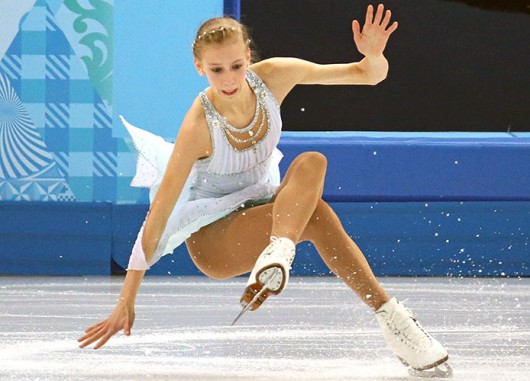
Polina Edmunds of the USA performs in the women’s free skate figure skating finals Feb. 20 during the Winter Olympics in Sochi, Russia.
Credit: Courtesy of MCT
In a sport played on ice, there are bound to be falls. Ohio State researchers, however, have come up with a footwear solution that could help figure skaters avoid injury and prolong their careers.
OSU associate professor of exercise physiology Steven Devor and his team compared the force with which female figure skaters and nonskaters landed after performing certain barefoot, off-ice jumps.
Devor said the researchers looked at females because women dominate the sport in numbers.
Olympic figure skating medals were awarded Thursday in Sochi, Russia, to the top-ranked skaters in the world. The gold medalist was 17-year-old Adelina Sotnikova from Russia. Three U.S. women competed in the event, but none ended the night on the podium.
According to the 2014 U.S. Figure Skating Membership Profile Fact Sheet, females comprise 72 percent of the U.S. figure skating membership.
Participants in the study completed jumps backward off a 20-centimeter-high platform, landing on one foot, and off a 2-foot-high platform, landing on two feet.
They landed on a tool called a force plate.
“Force plates measure not only how much force you come down on it with, but also measure how much wobble there is … This influences the amount of force going up through the joint,” Devor said.
The study found that skaters landed with more force on the plates than nonskaters, and had more “wobble” time after landing.
The ankle-restricting nature of the boots skaters train in weakens the ankle and causes that increased off-ice impact and instability after landing, Devor said.
The rigid, raised heeled on the boots limit ankle mobility and direct significant force to the metatarsal bones, Devor said in an article he co-wrote about the study called “Over the Edge: Lower extremity injuries in figure skaters.”
The article was published in the Lower Extremity Review by Devor and Nathan Saunders, a former U.S. singles and pairs figure skater and a doctoral candidate in the Department of Health Sciences at OSU.
The leather material of the boots that requires significant “break-in” time is another factor, Devor said.
“A large proportion of skaters’ training is spent breaking in boots or skating in broken-down boots, with little time spent training in optimal equipment … The resulting inconsistent level of boot ankle support not only contributes to performance inconsistency, and we suggest it may also increase the risk of ankle sprains,” Devor said in the article.
To overcome this, Devor said figure skaters should wear boots without heels and with more ankle room, made of synthetic material that does not require as much breaking in.
Wearing boots made of synthetic material could even improve skaters’ jumps, Devor said.
“If the ankle joint and some of the joints in the foot weren’t so restricted and you were able to get a better plantar flexion — that’s a movement at the ankle that results in the toe being pointed down like a gymnast or diver — if you could do that more easily, you would have a higher jump off the ice,” Devor said.
Devor also suggested skaters take more breaks while training, wear protective gear when practicing new moves and put more emphasis on off-ice strength and flexibility training.
Devor said he did not expect to find so many ways to limit injuries from the study.
“I knew there would be several different things you could tweak or do to lower rate of injury but I didn’t think there would be so many things done together to reduce likelihood of injuries. Not reducing altogether, just likelihood,” Devor said.
He added, however, he doesn’t see these boot and training changes happening overnight.
“Figure skating is very bound by tradition and the attitude that, ‘We’ve always done it this way, so why would we change?’ What we’re trying to do here is say there’s a body of literature that clearly indicated if you did things differently you’d have less injuries and extend skaters’ careers,” Devor said. “We can’t make that happen as scientists but we can get the ball rolling by starting a call for these things to happen.”
Alexa Bouts, a first-year in pre-exercise science and a member of the OSU figure skating club, said she began using boots made of synthetic material after an injury last year.
“I was doing a big jump and I twisted my ankle because my (leather) boots were so worn down … I had got them in December and they had already broken down by the end of February,” Bouts said. “I saw a lot of major skaters were wearing them and training with them for nine months to 13 months, which is unheard of for major skaters with all the jumps they do.”
Bouts said she has been pleased with the new boots so far.
Rina Saji, a first-year in neuroscience who is also on the OSU team, said her biggest injuries have been with her ankles.
“I’ve had a lot of stress fractures in my ankles. That’s from overtraining and repetitive amounts of jumps, especially when learning new skills,” Saji said.
Saji said she would like to try different boots, but might not be able to.
“I would consider switching but my biggest thing is I have wide feet and some of the synthetic models don’t form to my feet,” Saji said.
Devor said it is impossible to prevent all injuries, but athletes can reduce the number of them.
“You’re never going to eliminate injuries in athletes, not even anyone. What you can try to do is inform athletes based on well-done science and try to get them to change behaviors in such a way that you lower the likelihood of injury,” Devor said.


